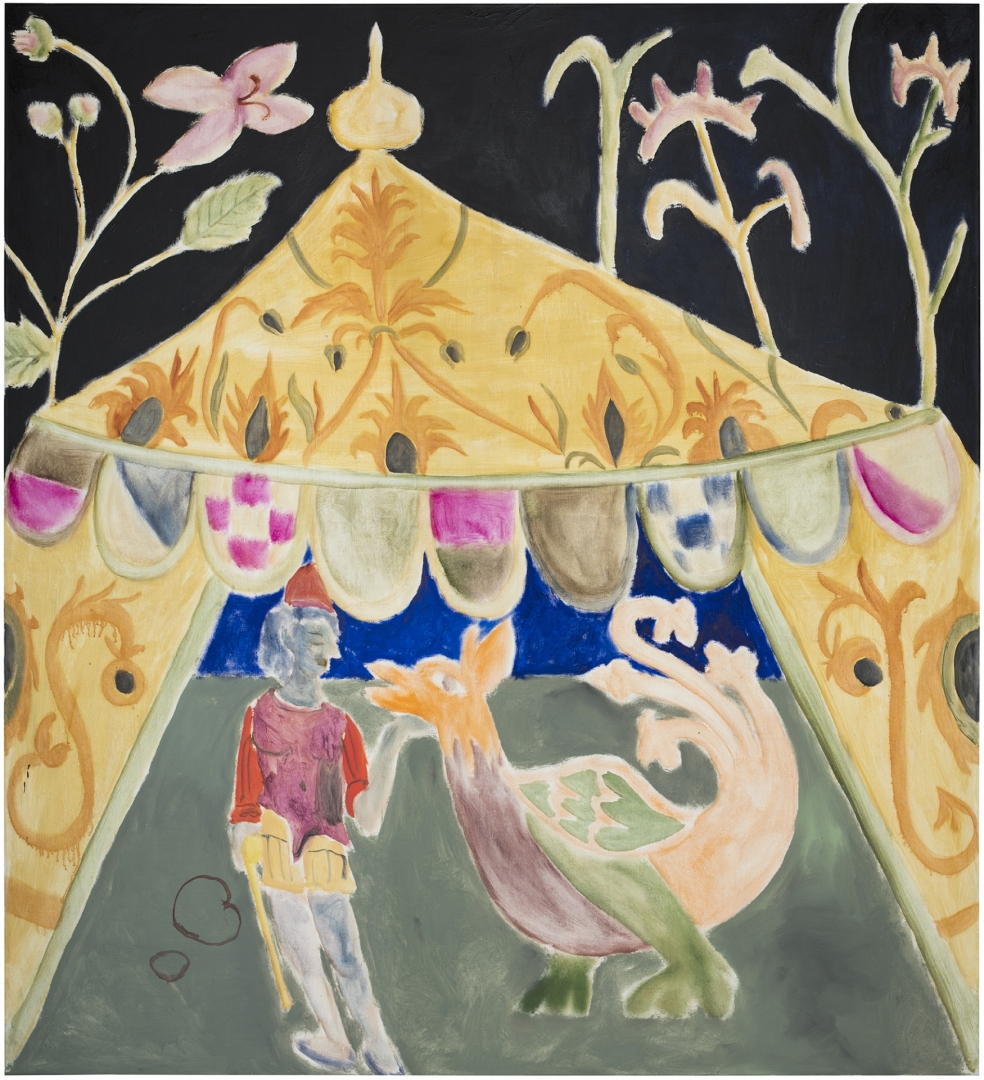Like their ancient original, in the Middle Ages, dragons were thought to be real, living creatures. This mythical figure represented fierceness in battle, was depicted on coats of arms, and became a popular theme in church art. The background to the work that gives the exhibition its title shows a painterly form of the knight’s tents found in medieval manuscripts and dragons from Celtic imagery. “To my mind, the dragon wields a subtle, but hefty resonance power: people’s own awareness of history is ignited, along with the cosmologies opened up by myths and people’s own animality, their subconscious fears and fantasies.” Turunen’s works raise the issue of the power relation between human and animal – did humans tame this reptilian creature, or was it vice versa. According to legend, facing a dragon is a battle for independence, requiring the prince to display exceptional courage and awareness of his own abilities.
Mastering and developing different methods is typical of Turunen as an artist. Switching media plays a major role in the creative process: this shift means the work in the making goes from the realm of consciousness and control to being solved by intuition. Eight tempera paintings on wood form the backbone of the The Dragon Tamer exhibition. This method demands planning: the basis for the painting is a drawing, instead of its point of departure being paint. The painting process involves rituals and symbols. This technique gave Turunen access to a previously unexperienced terrain of pigments: the startling shades of the new works, such as azurite, shungite, mineral blue and vagone green, come into their full glory in the gallery space. This series of works is complemented by dry-pastel drawings made ‘alla prima’, by lush oil paintings, and also by watercolours that are intimate in their narrative, executed using paper dyed with tea according to the Japanese tradition. Watercolour as a medium is closest to the world of medieval manuscripts, like a deep dive into the nature of paper.
This plethora of details and symbols invites us into the tale told in Turunen’s pictures. Given time, the works open up, layer by layer, and in relation to each other, not, however, in linear fashion, but ricocheting off each other. Field thistles, Matissian alla-prima painting, patterns from Luigi Bevilacqua’s velvet workshop, and tapestry art come up once again when Turunen names his sources of inspiration. Many of the works are like stills from a fairytale. The prince playing a lute, Venus’ peonies and Aphrodite’s tulips hovering in the air, roses blooming in a secret garden, snakes slithering over skin, butterflies gliding from one work to the next, and wide-open eyes that at first capture us with their gaze, until they close tightly shut.
Turunen’s art has the seductive power of opposites, alliances of good and evil, border zones between truth and fable, battlefields and serene dream images. The night sky in the background surprisingly turns to celestial blue, the atmosphere teeters on the border between sleep and wakefulness. Besides references to medieval imagery and the symbolist art movement, equally central for any interpretation are the rhythm and time division of these episodic, landscape-like picture surfaces. The recurrent triangle refers to the Holy Trinity in art history. The composition is based on regular, geometric elements in the spirit of Piero della Francesca. In Turunen’s paintings the triangle is their three-dimensional picture space – he uses geometric shapes to create the rules of the game for himself.
Aki Turunen (b. 1983) lives and works in Helsinki. He graduated with an MFA from the Academy of Fine Arts, Helsinki, in 2011. Turunen has also studied painting at the Royal Academy of Fine Arts in Copenhagen. His works have been shown in solo and group exhibitions in Finland, e.g. at the Helsinki Contemporary exhibition Gonzaga Yellow, Galleria Forum Box and Kluuvi Gallery, and in Denmark, e.g. at Martin Asbæk Gallery. Turunen also participated in the Charlottenborg Spring Exhibition in 2011. His works are, among others, in the collections of Museum of Contemporary Art Kiasma, the Saastamoinen Foundation, and the Finnish State Art Commission. In autumn 2021, the Finnish Art Society awarded Turunen a William Thuring designated prize.




